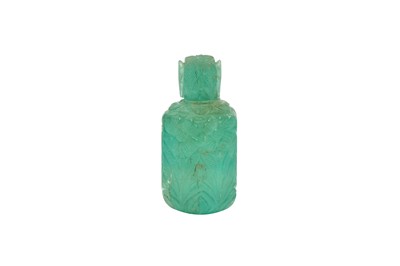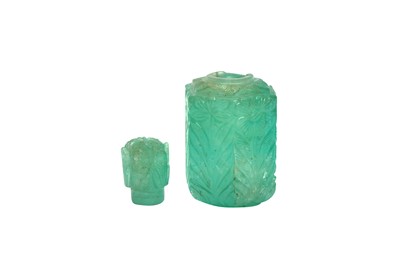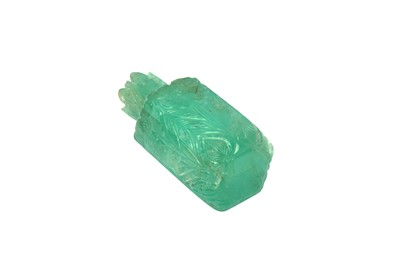28th Apr, 2023 11:00
Islamic Art - Property of a European Collector Part V
A CARVED MUGHAL EMERALD SCENT BOTTLE WITH STOPPER
Mughal India, 18th century
A CARVED MUGHAL EMERALD SCENT BOTTLE WITH STOPPER
Mughal India, 18th century
Of faceted hexagonal shape, resting on a flattened and smooth base, surmounted by a small stopper, each side of the body incised and carved with a floral design including four rosette and two iris stems with thick and lush foliage, each corner of the base and shoulders decorated with a drop-shaped leaf, and the stopper presenting six vertical leaves and a stylised rosette on the top, 5.2cm high and 3cm at widest points.
Provenance: Ader-Tajan, Hotel Drouot Auctions, Paris, Art Islamique, 8 November 1993, lot 72.
Since the dawn of civilisation, India has been a pivotal, worldly-renowned centre of the lapidary industry. Ancient literary evidence attests to the great mineral wealth of the Subcontinent and the skillfulness of its local gem cutters and jewellers. Spurred by the strong natural disinclination to grind mineral material away unnecessarily, Indian lapidary artists implemented relief-carving techniques in their creations more often than cutting and faceting, widely employed in the West (M. Keene, Treasury of the World, 2001, p. 110 and 128). This tradition of relief carving interested the surfaces of not only precious and semi-precious gems set in personal adornments but also several vessels carved out from hardstones, especially agate, rock crystal, and in the Mughal period, jade and emerald.
The significance and symbolism of emeralds in India stem from the ancient Hindu cosmological belief that they represented the planet Mercury, one of the Navgrahas (or 'nine seizers'), the nine celestial deities forming the universe and corresponding to seven planets and two personifications of the moon cycle. Wearing emeralds would grant the wearer apotropaic and positive qualities like luck, goodness, and purity. Green was also the favoured colour of Islam, further granting the success and appreciation for emeralds in Muslim lands (A. Jaffer, Treasures of the Mughals and the Maharajas: the Al-Thani Collection, 2017, p. 54).
The finely carved and faceted emerald in the present lot, shaped into a miniature scent bottle, is comparable to another emerald-carved cup attributed to Deccan or Mughal India and dating approximately to the late 16th - 17th century, now in the Al-Sabah Collection, Kuwait National Museum (inv. no. LNS 22 HS and published in M. Keene, Treasury of the World, 2001, p.133, cat.11.11). The exterior of our bottle is carved in relief presenting several single stems of flowers on each facet, a motif more and more recurrent on carved Mughal emeralds dating to the mid-17th century and later, as presented on an emerald bead and an emerald pendant in the Al-Thani Collection (A. Jaffer, Treasures of the Mughals and the Maharajas: the Al-Thani Collection, 2017, p. 63, fig. 18 and p. 71, fig. 30); and on the central hexagonal carved emerald set on a 19th-century armband (bazuband) in the Al-Sabah Collection (inv. no. LNS 141 J and published in M. Keene, Treasury of the World, 2001, p.114, cat.9.10). Rosettes, lotuses, and iris flowers were by far the most recurrent and favoured floral motifs.
Sold for £8,125
Includes Buyer's Premium
Do you have an item similar to the item above? If so please click the link below to submit a free online valuation request through our website.



